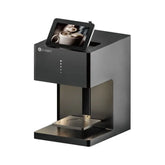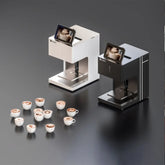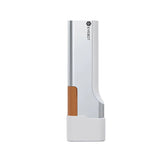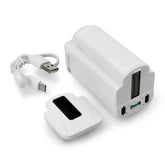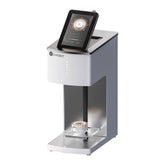How TIJ Printing Works
How TIJ Printing Works
Thermal Inkjet (TIJ) printing technology has revolutionized the way we print, offering fast, precise, and versatile solutions across various industries. Whether you're looking for a handheld TIJ printer for labeling or industrial applications, understanding the technology behind TIJ can give you insight into how it delivers quality results.
What is Thermal Inkjet Printing (TIJ)?
Thermal Inkjet printing works by applying heat to ink, causing it to vaporize and create a small bubble that forces the ink through a nozzle onto the printing surface. This process is repeated rapidly, allowing for the accurate placement of ink droplets on paper or other materials.
At its core, TIJ relies on two key components:
- Heating Element: This component heats the ink inside the printhead, causing it to vaporize and create pressure.
- Nozzle Array: The ink is expelled from tiny nozzles in precise droplets to form the printed image or text.
How Does TIJ Printing Work?
- Ink Heating: When a print command is given, an electrical signal activates the heating elements inside the printhead. The ink absorbs this heat, causing it to rapidly expand and form a small vapor bubble.
- Ink Ejection: The pressure from the vapor bubble forces the ink out through the nozzle, creating a fine droplet of ink. The droplet is carefully aimed at the surface, whether it be paper, packaging, or another material.
- Rapid Droplet Formation: This process happens in milliseconds, and the printer head moves across the print surface, forming lines of text or images by ejecting thousands of tiny droplets in a high-speed, coordinated manner.
- Resolution and Quality: The quality of TIJ printing is often determined by the density and precision of the droplets. Higher-resolution printers use smaller nozzles and finer ink droplets to produce sharp, clear text and images. For example, handheld printers such as those from EVEBOT are designed with high-resolution printheads to ensure that text and barcodes remain crisp even on small labels.
The Challenge of Portability in TIJ Printers
While portable, most handheld TIJ printers on the market are quite bulky and heavy, often resembling a hammer-like shape, with weights typically exceeding 2kg (4lbs). These printers, while functional, can be cumbersome, especially for users looking for something more compact and convenient for mobile applications.

EVEBOT Portable TIJ Printer Development
At EVEBOT, we noticed the limitations of traditional TIJ printers and set out to create a more compact, lightweight solution without compromising on printing performance. Our goal was to achieve the same (or even larger) printable width while reducing the size and weight.
In March 2018, we embarked on the development of the PrintPen—a portable food printer that weighs only 255g, about one-tenth the size of typical handheld TIJ printers. Along with this, we developed a custom ink cartridge that is half the size of the ones used in conventional portable TIJ printers.

Left: EVEBOT portable printer ink, Right: Conventional portable TIJ printer ink
Our PrintPen uses the same thermal inkjet printing technology but in a much more compact form, making it perfect for on-the-go applications, such as printing on food packaging. In 2020, we launched the first-generation PrintPods and also began developing solvent ink, which is commonly used in industrial TIJ printers.
 (The Ink Cartridges tested and scrapped during solvent ink development)
(The Ink Cartridges tested and scrapped during solvent ink development)
The journey wasn’t without challenges—our solvent ink development faced significant obstacles as we didn’t have any prior industry knowledge to guide us. However, by the end of 2023, we successfully developed our solvent ink and immediately launched the PrintInd, designed specifically for industrial uses. The PrintInd features a different voltage from the PrintPods, and the ink cartridges are not interchangeable.
EVEBOT’s Three Portable Printers
EVEBOT now offers three distinct portable printers:
- PrintPods: Uses water-based ink for lightweight logo printing on surfaces such as paper, fabric, and wood.
- PrintInd: Uses solvent ink for industrial applications, offering performance similar to conventional TIJ printers.
- PrintPen: A unique portable printer that uses edible ink for printing directly on food packaging.
Advantages of Thermal Inkjet Printing
- Precision and Clarity: TIJ printers produce sharp, clear prints that are highly readable, essential for applications like barcoding and product labeling.
- Low Maintenance: TIJ systems have fewer moving parts compared to traditional printers, reducing maintenance and the risk of mechanical failure.
- Compact and Portable: While many TIJ printers are bulky, EVEBOT’s portable models are designed to be lightweight and easy to carry, perfect for mobile use.
- Cost-Effective: TIJ technology is often more affordable in terms of operating costs, particularly with easy-to-replace ink cartridges.
Applications of TIJ Printing
- Packaging: TIJ printers are commonly used to print product information, expiry dates, and lot codes directly onto packaging materials.
- Logistics and Warehousing: Handheld TIJ printers are perfect for on-the-go labeling in warehouses, offering ease of use and mobility.
- Retail and Manufacturing: TIJ is also used for printing on retail products, ensuring that important information like pricing, branding, and manufacturing details are visible to customers.
